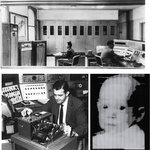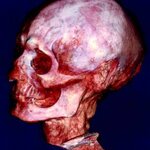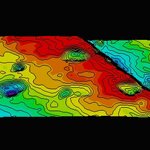Technology

It was a grainy image of a baby—just 5 centimeters by 5 centimeters—but it turned out to be the well from which satellite imaging, CAT scans, bar codes on packaging, desktop publishing, digital photography and a host of other imaging technologies sprang.
[Top] The room-sized Standards Eastern Automatic Computer (SEAC) was used to create the first scanned image. [Bottom L.] National Bureau of Standards (NBS) researcher R.B. Thomas shown operating the SEAC scanner (the control console is in the background). [Bottom R.] The first digital image made on a computer in 1957 showed researcher…

Particles of light serving as “quantum keys”—the latest in encryption technology—have been sent over a record-setting 200-kilometer fiber-optic link by researchers from the National Institute of Standards and Technology (NIST), NTT Corp. in Japan, and Stanford University.
The experiment, using mostly standard components and transmitting at telecommunications frequencies, offers an approach for making practical inter-city terrestrial quantum communications networks as well as long-range wireless systems using communication satellites.
The demonstration, described in Nature Photonics,* was…

A new experiment has shown that it's possible to store multiple rudimentary memories in an artificial culture of live neurons. The ability to record information in a manmade network of neurons is a step toward a cyborg-like integration of living material into memory chips. The advance also may help neurologists to understand how our brains learn and store information.
Itay Baruchi and Eshel Ben-Jacob of Tel-Aviv University used an array of electrodes to monitor the firing patterns in a network of linked neurons. As previous studies have shown, simply linking the neurons together leads them…

MultiDetector Computed Tomography (MDCT) can aid forensics teams in determining if a person has drowned, according to a study published in the June issue of Radiology.
MDCT is comparable to conventional autopsy in demonstrating airway froth and sediment that are indicative of drowning.
Skull using MDCT. Credit: American Journal of Roentgenology
"Our findings show that MDCT can be used either to facilitate or reduce the need for conventional autopsy when drowning is the suspected cause of death," said lead author Angela D. Levy, M.D., from the Department of Radiology, Uniformed Services…

In the future doctors will be able to find more tumors at an early stage while using a smaller x-ray dose for each examination. Color x-rays offer new possibilities for medical diagnoses. This spring Mid Sweden University is presenting three dissertations in the field of digital color x-rays.
Digital color x-rays are based on the same advanced technology that is used when nuclear physicists look for new elementary particles. The great scientific challenge in constructing a color x-ray camera is to be able to shrink the large-scale detection equipment used by nuclear physicists to the…

British scientists working with David A. Russell have made it possible to gain information about the lifestyle of a person from their fingerprint - this includes drug and doping transgressions, what foods have been consumed, diagnosis of diseases and they can even use specific antibodies to differentiate between the fingerprints of smokers and nonsmokers.
Knowing more about the lifestyle of the person who made the fingerprints will allow investigators to shrink the pool of crime suspects, the researchers say.
Researchers want to coax all of these secrets out of the tiny traces of…

A smokeless cannabis-vaporizing device delivers the same level of active therapeutic chemical and produces the same biological effect as smoking cannabis, but without the harmful toxins, according to UCSF researchers.
"We showed in a recent paper in the journal ‘Neurology’ that smoked cannabis can alleviate the chronic pain caused by HIV-related neuropathy, but a concern was expressed that smoking cannabis was not safe. This study demonstrates an alternative method that gives patients the same effects and allows controlled dosing but without inhalation of the toxic products in smoke," said…

The Fumanya site, in the Bergueda region of central Catalonia, is so delicate that experts cannot get physically close enough to the tracks to examine them.
In the years since the tracks were discovered they have been exposed to the elements, and as a result are severely weathered and eroding at a rapid rate.
To make things even more difficult, the tracks are imprinted into near-vertical rock faces.
Palaeontologists feared the tracks could be lost forever - but a permanent and detailed record has now been created using cutting-edge equipment.
Using a high-tech laser scanning system called…

Amnesty International USA is using powerful satellite cameras to monitor highly vulnerable villages in war-torn Darfur – the first-ever technological capability by human rights defenders to track possible targets of attack, prevent new atrocities and save lives. The human rights organization is inviting ordinary people worldwide to help protect 12 villages by visiting the Eyes on Darfur project website (www.eyesondarfur.org) and put Sudanese President al-Bashir on notice that the areas are being watched around the clock.
"Despite four years of outrage over the death and destruction in Darfur…

Terahertz (THz) radiation, or far-infrared light, can penetrate clothing and other materials to provide images of concealed weapons, drugs, or other objects. However, THz scanners must usually be very close to the objects they are imaging because water vapor in air absorbs THz radiation so strongly that most of it never reaches the object to be imaged.
At the upcoming CLEO/QELS meeting in Baltimore, an MIT-Sandia team will demonstrate the first real-time THz imaging system that obtains images from 25 meters away. The technique takes advantage of the fact that there are a few "windows," or…